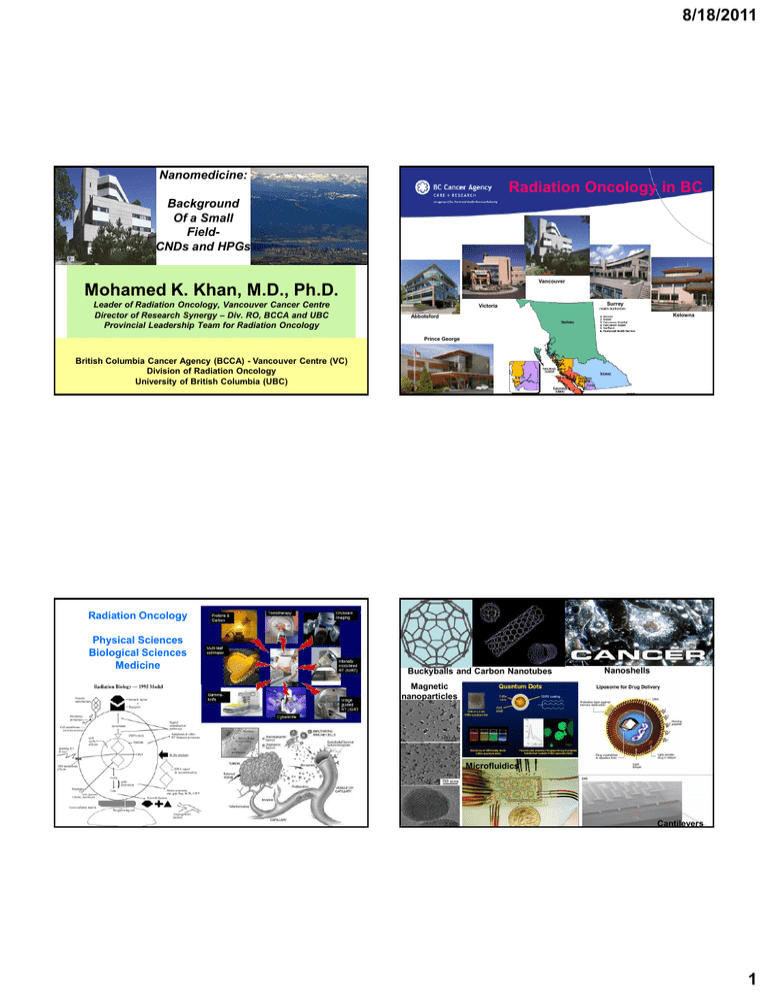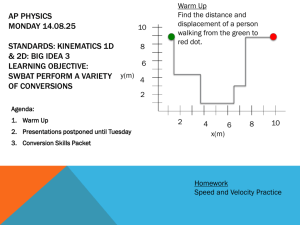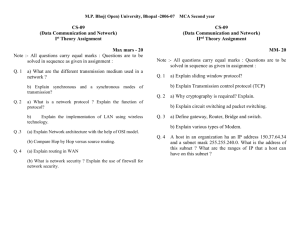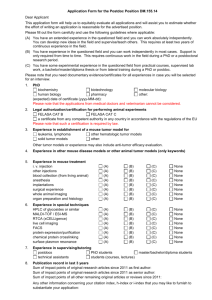8/18/2011 Mohamed K. Khan, M.D., Ph.D. Radiation Oncology in BC Nanomedicine:
advertisement

8/18/2011
Nanomedicine:
Radiation Oncology in BC
Background
Of a Small
FieldCNDs and HPGs
Vancouver
Mohamed K. Khan, M.D., Ph.D.
Leader of Radiation Oncology, Vancouver Cancer Centre
Director of Research Synergy – Div. RO, BCCA and UBC
Provincial Leadership Team for Radiation Oncology
Victoria
Surrey
Kelowna
Abbotsford
Prince George
British Columbia Cancer Agency (BCCA) - Vancouver Centre (VC)
Division of Radiation Oncology
University of British Columbia (UBC)
MKK 8/04/11
MKK 8/04/11
Radiation Oncology
Physical Sciences
Biological Sciences
Medicine
Buckyballs and Carbon Nanotubes
Nanoshells
Magnetic
nanoparticles
Microfluidics
MKK 8/04/11
MKK 8/04/11
Cantilevers
1
8/18/2011
Hyperthermia Enables Tumor-specific Nanoparticle
Delivery: Effect of Particle Size
1Garheng Kong, Rod D. Braun, and Mark W. Dewhirst2
Liposomes are lipid-based
nanoparticles used extensively
in the pharmaceutical and
cosmetic industries because of
their capacity for breaking
down inside cells, once their
delivery function has been met.
Department of Biomedical Engineering [G. K.] and Department of Radiation Oncology [R. D. B., M.
W. D.], Duke University Medical Center, Durham, North Carolina 27710
ABSTRACT
The efficacy of novel cancer therapeutics has been hampered by the ability to deliver these agents to the
tumor at effective concentrations. Liposomes have been used as a method to overcome some delivery
issues and, in combination with hyperthermia, have been shown to increase drug delivery to tumors.
Particle size has been shown to affect the delivery of liposomes, but it is not known how hyperthermia
affects size dependence. This study investigates the effect of hyperthermia (42°C) on the
Liposomes were the first
engineered nanoparticles used
for drug delivery but problems
such as their propensity to fuse
together in aqueous
environments and release their
payload, have lead to
replacement, or stabilization
using newer alternative
nanoparticles.
extravasationof different sized nanoparticles (albumin; 100-, 200-, and 400-nm liposomes)
from tumor microvasculature in a human tumor (SKOV-3 ovarian carcinoma) xenograft grown in mouse
window chambers. In this model (at 34°C), no liposomes were able to extravasate into the tumor
interstitium. Hyperthermia enabled liposome extravasation of all sizes. The magnitude of
hyperthermia-induced extravasation was inversely proportional to particle size. Thus, at normothermia
(34°C), the pore cutoff size for this model was between 7 and 100 nm (e.g., liposomes did not extravasate).
At 42°C, the pore cutoff size was increased to >400 nm, allowing all nanoparticles tested to be delivered to
the tumor interstitium to some degree. With hyperthermia, the 100-nm liposome experienced the
largest relative increase in extravasation from tumor vasculature. Hyperthermia did not enable
extravasation of 100-nm liposomes from normal vasculature, potentially allowing for tumor-specific
delivery. These experiments indicate that hyperthermia can enable and augment liposomal drug delivery to
tumors and potentially help target liposomes specifically to tumors.
[CANCER RESEARCH 60, 4440–4445, August 15, 2000]
http://en.wikipedia.org/wiki/File:Liposome.jpg
MKK 8/04/11
http://biotech.about.com/od/nanotechnology/a/typesnanopart.htm
Nanoshells
Buckyballs and Carbon Nanotubes
Both members of the fullerene structural class,
carbon based, lattice-like, potentially porous
molecules.
Also referred to as core-shells,
nanoshells are spherical cores
of a particular compound
surrounded by a shell or outer
coating of another, which is a
few nanometers thick.
Buckyballs are spherical in shape
Carbon tubes are cylindrical. The diameter of a
carbon tube can be several nm but the length can be
much greater, up to several mm, depending on its
intended use.
MKK 8/04/11
Buckminsterfullerene C60,
also known as the buckyball,
is the smallest member of the
fullerene family.
Once the nanoshells enter
tumor cells and radiation
treatment is applied, they
absorb the energy and heat up
enough to kill the cancer cells.
Bone cells grown on carbon nanotubes
Laura Zanello,
University of California,
Riverside
MKK 8/04/11
http://en.wikipedia.org/wiki/Nanomaterials
http://biotech.about.com/od/nanotechnology/a/typesnanopart.htm
MKK 8/04/11
Nanoshell-mediated near-infrared thermal
therapy of
tumors under magnetic resonance guidance
L. R. Hirsch*, R. J. Stafford†, J. A. Bankson†, S. R. Sershen*,
B. Rivera‡, R. E. Price‡, J. D. Hazle†, N. J. Halas§,
and J. L. West*¶
PNAS November 11, 2003 vol. 100 no. 23 13549–13554
(AP) Tiny gold nanoshells that
contain a bit of mica In their center.
A group of Texas researchers injected
the nanoshells - so small it would
take 5,000 of them to reach the size of
a poppy seed - into tumors in mice.
They then exposed the tumors to near
infrared radiation, heating them
enough to kill the cancer but without
injuring nearby normal tissue.
http://biotech.about.com
2
8/18/2011
Quantum dots light up individual DNA binding proteins
The photoluminescence from different
sized quantum dots
DNA-binding proteins
Quantum Dots: Also known as nanocrystals, quantum dots are
nanosized semiconductors that, depending on their size, can emit
light in all colours of the rainbow.
Rats are injected with the dots,
which find their way to cancer
cells.Source: Xiaohu Gao ,
University of Washington.
These nanostructures confine conduction band electrons, valence
band holes, or excitons in all three spacial directions.
Experimental steps for mapping DNA binding proteins.
a) Crosslinking DNA-binding proteins (black) to DNA
b) Staining DNA (blue), quantum dot labeling of bound proteins (green),
and labeling of specific reference sequences on DNA with quantum dots (red).
c) Complexes are aligned on a glass coverslip and imaged by a fluorescence microscope.
Image analysis provides information on protein location.
d) Pseudo color image of RNAP-biotin crosslinked to aligned DNA and bound to
streptavidin quantum dots of 4 different colors (Scale-bar 10 µm). (Image: Dr. Ebenstein, UCLA)
Examples of quantum dots are semiconductor nanocrystals and
core-shell nanocrystals, where there is an interface between
different semiconductor materials.
They have been applied in biotechnology for cell labelling and
imaging, particularly in cancer imaging studies.
MKK 8/04/11
Transcription factors
Various polymerases
Nucleases
Histones
http://biotech.about.com/od/nanotechnology/a/typesnanopart.htm
MKK 8/04/11
Magnetic nanoparticles
http://www.kusoz.com/blog/
Nano Letters (”Lighting Up Individual DNA Binding Proteins with Quantum Dots”).
A Magnetically Triggered Composite Membrane
for On-Demand Drug Delivery
Class of nanoparticle which can be manipulated using
magnetic fields
Todd Hoare†, Jesus Santamaria‡§, Gerardo F. Goya§, Silvia Irusta‡§,
Debora Lin , Samantha Lau , Robert Padera , Robert Langer and Daniel S. Kohane*#
McMaster University, Hamilton, Ontario; University of Zaragoza, Zaragoza, Spain, Harvard Medical School, MA
Nano Lett., 2009, 9 (10), pp 3651–3657
Commonly consist of magnetic elements such as
iron
nickel
cobalt
& their chemical compounds
Hyperthermia
Another interesting
therapy is based on
the ability of MNPs to
be heated when a
time-varying
magnetic field is
applied.
TEM of 15nm
Fe3O4 magnetic
nano particles
MKK 8/04/11
images.pennnet.com
Nanocomposite membranes based on thermosensitive, poly(N-isopropylacrylamide)-based
nanogels and magnetite nanoparticles have been designed to achieve “on-demand” drug
delivery upon the application of an oscillating magnetic field. On−off release of sodium
fluorescein over multiple magnetic cycles has been successfully demonstrated using prototype
membrane-based devices. The total drug dose delivered was directly proportional to the
duration of the “on” pulse. The membranes were noncytotoxic, were biocompatible, and
retained their switchable flux properties after 45 days of subcutaneous implantation.
MKK 8/04/11
3
8/18/2011
Microfluidics
Cantilevers
Nanomechanical detection of
biological molecules
FIGURE 1. A microfluidic chemostat.
From the following article:
The origins and the future of microfluidics
George M. Whitesides
Nature 442, 368-373(27 July 2006)
doi:10.1038/nature05058
Nanocantilevers for ssDNA detection. (a) An
array of piezoresistive cantilevers in a fluidic
well (Cantion Inc.). The cantilevers are 120
microns long and are separated by 470
microns. (b) Cantilever surface stress variation
as a function of ssDNA probe (20-mers)
immobilization and hybridization of fully
complementary 20-mers using a piezoresistive
cantilever array (taken with a reference
cantilever). Thiol-modified ssDNA probes (20mers) were immobilized on one side of a
cantilever with a vacuum-deposited gold layer
of 40 nm thickness
Microfluidic devices — here, a microfluidic chemostat used to study
the growth of microbial populations — now routinely incorporate
intricate plumbing. This device includes a high density of pneumatic
valves. The colours are dyes introduced to trace the channels.
(Image reproduced, with permission, from ref. 65.)
MKK 8/04/11
Mark Ming-Cheng Cheng, et al., Current Opinion
in Chemical Biology 2006, 10:11–19
MKK 8/04/11
Nanowires
Label-free electronic
sensors of genes and
proteins
A change in chemical potential accompanying a
target/analyte binding event, such as DNA
hybridization, can act as a field effect gate upon the
nanowire, thereby changing its conductance.
One compelling advantage of nanowire
sensors is that the number and density of the
sensor elements is limited only by the ability
to electronically address individual nanowires.
Very dense nanowire sensor circuits may be
addressed. Thus, large-scale circuits can,
in principle, be constructed within very
small (microfluidics) environments,
thereby enabling measurements of large
numbers of different genes and proteins
from very small tissue samples, or even
single cells.
MKK 8/04/11
Mark Ming-Cheng Cheng, et al., Current Opinion
in Chemical Biology 2006, 10:11–19
MKK 8/04/11
2006, 10:11–19
4
8/18/2011
An Ideal Smart Therapeutic
Nanodevice
Targets to Tumor
or Stromal Elements (Angiogenic
Endothelial Cells)
Specifically or Non-specifically
Has Imaging Capability to Document
Presence in Tumor
Delivers Therapeutic Agents Based on Tumor
Characteristics
Might Use Non-invasive External Trigger to
Release Therapeutics
Documents Response to Therapy
Identifies Residual Tumor cells
MKK 8/04/11
M. Khan,
MKK 8/04/11
Poly(amidoamine) PAMAM synthesis
(Tomalia, 1983)
NH2
H2N
OMe
(1)
O
NH2
H2N
Core
NH
O
N
OMe
(1)
H2N
N
HN O
(2)H2N
H2N
Generation 1
Generation 0
H2N
NH2
N
H2N
NH2
N
N
NH2
NH2
NH2
N
NH2
N H2
H2N
N
N
O
O
HN
NH2
(2)H2N
NH2 H2N
O NH
N
OMe
(1)
N
Mw=6,906
N=62
Z=32
14,211
126
64
28,826
234
128
60,713
254
256
O
H2N
NH2
H2N
H2N
N
H2N
N
N
H2N
Generation 2
N
H2N
H2N
NH2
N
N
Generation 3, etc.
Up to generation 12
NH2
H2N
N
N
N
N
NH2
NH2
N
N
N
(2)H2N
N
NH2
NH2
NH2
NH2
NH2
Dendrimers differ from classical polymers by their extraordinary symmetry,
high branching, and maximized terminal functionality.
MKK 8/04/11
Synthetic, non-immunogenic, protein-like hybrid particles with
tunable properties and in sizes similar to fundamental proteins
MKK 8/04/11
D. Tomalia
5
8/18/2011
Synthesis of Dendrimer
Possible Multifunctional Architectures
Based on Dendrimers
Nanocomposites
Template with multiple active sites
Complexed (mobil) ions
Dendrimer
Immobilized atoms/molecules
Composite Nanodevice
Contrast Agent (x-ray,MRI)
Drug-Delivery
indicator
Sensor-Cell death
D
+ MY
Dendrimer
[(MY)n-D]
Complex
+X
-Y
{(MX)n-D}
Cancer
cell targeting
Nanocomposite
Therapeutic module
Dendrimers provide uniform polymeric template molecules in variable sizes and with
tunable compatibility. The resulting “soft” composite nanoparticles combine the
properties of the encapsulated inorganic matter and the biofriendly macromolecule
Balogh, Swanson, Spindler, Tomalia, Proc. ACS PMSE, 1997, 77, 118
Balogh and Tomalia: “Nanocomposites of Dendritic Polymers” US 6,664,315 B2, (2003), US 6,475,994 (2002),
Balogh,, et al., “Dendrimer-based Nanoscopic Sponges and Metal Composites” US 5,938,934 (1999).
MKK 8/04/11
The composite nanodevice carries
Functional termini are covalently attached
the therapeutic and/or other
to the dendrimer - a tough synthetic task
functions in its interior
- a simple approach
MKK 8/04/11
D. 11 nm Ng-Au-CND
5 minutes
300
1 hour
Biodistribution Studies
1 day
50
4 days
250
45
B16F10 melanoma cells (or MatLyLu) were grown on the dorsal surface of a mouse
C57Bl6/J (or athymic nude) mice. The mouse was then injected via tail vein with the
nanocomposite solution (400 g of DNC each).
40
-
-
-
200
35
-
% ID /g o rg an
First task is to know the biodistribution of the host as
f(size,charge)
30
150
25
20
100
15
10
50
5
Both
0
0
Blood
Brain
Mus cle
5nm and 11nm
50
Pancreas
Tumor
Heart
Kidneys
Lungs
Liver
B. 5 nm Ng-Au-CND
Negatively
1 hour
1 day
4 day s
40
Charged
- - --
35
% I D/ g or gan
d=5, 11, and 22 nm {Au}
nanocomposite particles
([Au0]=3.11%)
Charge: PS, NgS and NS
Spleen
5 minutes
45
30
25
20
15
10
5
http://www.braintreesci.com/metabolic.htm
MKK 8/04/11
L.Balogh……M K. Khan., Nanomedicine 2007
L.Balogh……M K. Khan., Nanomedicine 2007
0
MKK 8/04/11
Blood
Brain
Musc le
Pancreas
Tumor
Heart
Kidney s
Lungs
Liv er
Spleen
6
8/18/2011
Size, Charge and Other Factors
Effect Interaction of Nanoparticles with
Complex Biologic Systems
DOD- DAMD17-03-1-0018
+ +
++
+
+
+ + +
+
+
+ +
+
+
MKK 8/04/11
MKK 8/04/11
+
+
+
Neutral
- -
Negative
M. Khan and L. Balogh
+
Positive
Neutral
- - - -- - - -
+
+
+
Positive
-
+
-
- - Negative
L. Balogh and M. Khan, Dendrimer Nanocomposites for Cancer Therapy
In Nanotechnology in Cancer Therapy, M. Amiji editor, CRC Press.
M. Khan….L Balogh, Technol Cancer Res Treat. 2005 Dec;4(6):603-13
L.Balogh……M K. Khan., Nanomedicine 2007
Nanoletters,Submitted
MKK 8/04/11
MKK 8/04/11
7
8/18/2011
In Vitro Toxicity Analysis
Tumor Cell and Normal Cells
Toxicity Assessment
MKK 8/04/11
In Vivo Toxicity Analysis (Long and Short-term)
Clinical toxicity tables
Weight measures
Serum Analysis
Histochemical tissue analysis
Inflammation markers
Immune reactions
MKK 8/04/11
In Vivo – Serum Analysis
{Au} Composite Nanodevices
5 nm {Au} Composite Nanodevices
Shows No Clinical Toxicity
Routine CBC
(Complete Blood Cell Count)
WBC
RBC
HGB
HCT
PLT
3 months
Weight Change (g)
2 Weeks
Routine Differential
Days
MKK 8/04/11
White Blood Cells
Red Blood Cells
Hemoglobin
Hematocrit
Platelet Count
Days
Submitted to Nanomedicine
White Blood Cells
Neutrophils
Monocytes
Eosinophils
Basophils
Electrolytes
Na
K
Ca
Phos
Glucose
BUN
Creatinine
Total Protein
Albumin
Cholesterol
MKK 8/04/11
8
8/18/2011
Histopathology
Lung
Spleen
Inflammation
Pancreas
PBS
+
-
Nt
Other Organs:
Esophagus
Thyroid Gland
Brain
Stomach
Adrenal gland
Bladder
Duodenum
Testicle / Epididymis
Skeletal Muscle
Small and Large Intestine Seminal Vesicle
Skin
MKK 8/04/11
Trachea
Thymus
Eye
Submitted to Nanomedicine
MKK 8/04/11
Possible Multifunctional Nanodevice
Architectures
Inflammation:
Rocket Immuno-Electrophoresis
100
65
% Amine Terminal Groups
40
27
Nanocomposite
12
0
LPS
Contrast Agent (x-ray,MRI)
Drug-Delivery
indicator
Sensor-Cell death
Cancer
cell targeting
Therapeutic module
MKK 8/04/11
Nanoletters, Submitted
MKK 8/04/11
9
8/18/2011
Can we Modify the
Surface
of the Nanoparticles to Permit
Direct Targeting?
MKK 8/04/11
MKK 8/04/11
Target matters
Folate
Biodistribution of targeted dendrimer nanodevice in KB tumor bearing nu/nu mice
Human oral squamous cell carcinoma xenograft in athymic (nu/nu) mice
Folate
KB cells are known to overexpress folate binding membrane protein
Biodistribution of dendrimers in KB tumor tissue harvested
from athymic mice
• Athymic mice were fed folate-free diet for one week before tumor cell inoculation
• Subcutaneous flank inoculations of KB tumor cells
• Growth for Two weeks followed by Dendrimer Injections
10
Dendrimers tested
• Free Folic Acid (dihydrate)
IV injected 5 mins before
dendrimer injection
• 5 nm Folate conjugated
Dendrimer (G5-FA)
KB athymic
mouse model
5 mins
2 hour
1 day
4 days
7 days
% ID / g
8
Dendrimers tested
• 5 nm Neutral Surface
Dendrimer (NSD) = control
• 5 nm Folate conjugated
Dendrimer (G5-FA)
G5
6
G5-FA
4
G5-FA + FFA
2
0
-24
5 mins
1 day
4 days
0
24
48
72
96
Time (hours)
Organs & Tissues harvested, processed and counted
MKK 8/04/11
Kukowska-Latallo JF et al, Cancer Res. 2005 Jun 15;65(12):5317-24
MKK 8/04/11
Cancer Research 2005, 65, 5317-5324
10
8/18/2011
Folate-Targeted Nanoparticle Delivery of Chemotherapy
Decreased Tumor Growth
Increased Survival
Decreased Toxicity
Folate
MTX
IMAGING
Cancer Res. 2005 Jun 15;65(12):5317-24
MKK 8/04/11
MKK 8/04/11
Nanocomposite Molecular Imaging
Currently Under Investigation
Imaging Nanocomposites Targeting
Tumor Microvasculature
RO1 - Mohamed Khan, M.D., Ph.D.
L. Balogh, Ph.D., Co-PI
•SPECT
*
RGD
The objective is to improve early detection and understanding of cancer by developing
an imaging approach based on radioactive nanocomposite devices (NCDs) allowing
multi-modality imaging
•PET
Target: avb3 integrin
RGD
•MRI
*
•CT
*
198Au
and 67Cu containing
nanocomposites
•TEM
Cor
Sag
MKK 8/04/11
Axial
500 nm
•X-ray Detector
100
nm
Methods:
TEM - Intracellular/Cellular Imaging
Autoradiography - Multicellular/Tissue
SPECT - Whole Animal Imaging
Nanocomposites may be directed to the tumor microvasculature by: differing size and
charge, or
by using surface moieties that specifically target the angiogenic tumor microvasculature
(Intratumoral)
MKK 8/04/11
11
8/18/2011
Targeting the Angiogenic Tumor Microvasculature
Tumor Microvascular Targeting
Assesment of cRGD Peptide Binding to AlphavBeta3 Integrin
Absorbance at 450nm
0.500
RGD
PBS Injected
• Intravascular Injection
0.400
•MatLyLu Prostate Cancer
Mouse Tumor Model System
0.300
Binding to
avb3 receptor
0.200
0.100
Biotintylated 5cRGD-Au-CND
0.000
Au-BT-CND
PEG2cRGD-BT
Au-cRGDBT-CND
4X
40X
400X
cRGD Competition Peptide
Confocal Fluorescence Microscopy of HDMECs Exposed to cRGD-BT-Au-CND
Biotintylated Au-CND
Biotintylated 5cRGD-Au-CND
Tail vein
RGD injections
MKK 8/04/11
Lesniak et al., Bioconjugate Chemistry (2007) 18 (4): 1148-1154.
Electron Micrograph of In Vivo 5 nm Nanocomposite
Deposition in Mouse B16 Melanoma Tumor Tissue
MKK 8/04/11
Kariapper et al., in preparation
Intratumoral Imaging
Radiograph
Nanodevice
distribution
L o w M ag n ifica tio n (4,6 00 x )
1X
H ig h M a g n ifica tio n (6 4 ,0 0 0x )
50X
1X
Haematoxylin & Eosin Staining
Tissue & Cellular Architecture
= CND
Immunohistochemistry
Mouse B16 Melanoma:
Balogh LP..… Khan M.K., Chimica Oggi (Chemistry today), 2002, 20 (5): 35-40
Human DU145 Prostate CA: Balogh LP ..…Khan M.K., PharmaChem, 2003, 2 (4) 94-99
MKK 8/04/11
Microvasculature
50X
MKK 8/04/11
12
8/18/2011
Hyperspectral Imaging of
Mouse Prostate Tumor
Images post 48-hr-In Vivo, Real-time, Live Mice
Targeted CND in Tumor
Control
LBMK-21 (Au-5cRGD-BT6-CND; 2.5 ug
(Streptavidin-AlexaFluor-680; 5 ug)
& SA-AlexaFluor680; 5 ug)
Untreated Tumor
MKK 8/04/11
MKK 8/04/11
Kariapper et al., in preparation
Radiation
THERAPY
and
Isotopes
MKK 8/04/11
MKK 8/04/11
13
8/18/2011
Potential Forms of Radiotherapy:
Prostate Brachytherapy
Gamma rays
Electrons
Beta particles
(e-’s generated in nuclear decay)
Protons
Neutrons
Alpha Particles
MKK 8/04/11
MKK 8/04/11
Radioactive Gold Nanodevice
Treated Mice - Nanobrachytherapy
50% reduction was
achieved in eight days as
a result of a single injection
NanoBrachytherapy and NanoSTART
(Systemic Targeted NanoRadiation
Therapy): Targeting the Angiogenic
Microvasculature for cancer TREATMENT
DODM. Khan and L. Balogh
Mice were injected intratumorally
(B16 melanoma, C57Bl6/J mice)
L o w M ag n ifica tio n (4,6 00 x )
H ig h M a g n ifica tio n (6 4 ,0 0 0x )
198Au
RGD
Tail vein
injections
MKK 8/04/11
Khan…..Balogh, Nanomedicine, 2008 Mar;4(1):57-69
MKK 8/04/11
198Au
Target = anb3 integrin
14
8/18/2011
Possible Multifunctional Nanodevice
Architectures
Nanocomposites-Imaging and Therapy
Mohamed Khan, MD, PhD
and
Lajos Balogh, PhD
Nanocomposite
Contrast Agent (x-ray,MRI)
Drug-Delivery
indicator
Sensor-Cell death
Nuclear Reactor
*Leah Minc, PhD
Christopher Becker, PhD
Physics-Imaging/Therapy
*Peter Roberson, PhD
*Andras Sablauer, MD,PhD
Manju Sharma, PhD
*Dariel Nazereth, PhD
*Matthew Podgorsak, Ph.D.
Nuclear Medicine-Imaging
*Michael Haka, MD
Cancer
cell targeting
Therapeutic module
Folate Collaborators
James R. Baker, MD
Kimberly Candido, MD
Istvan Majoros, PhD
Balazs Keszler, PhD
MKK 8/04/11
MKK 8/04/11
MKK 8/04/11
MKK 8/04/11
*Muhammad Taju Kariapper, PhD
*Venu Kastagopolan, PhD
Bindu Nair, PhD
*Wojchiech Lesniak, PhD
*M. Tayib Ould Ely, PhD
*David Rigual, M.S.
Shraddha Nigevakar, PhD
Lok Yun Sung
Alla Kwitny
Kerstin S. May
Areej El-Jawahri
Mikel Llanes
Brian Bolton, MD
Fatema Mamou, MPH Marion Seggio
Emily Waite
Hanna Roy
Remy Bezimungu
Cindy Ta, MD
PK/PD:
*Don Mager, PhD
*Gerald Federley
*Allen Forrest, PhD
*Patrick Smith, PhD
Engineering:
*Matthew O’Donnell, Ph.D.
TEM:
Dorothy Sorenson, BA
Christopher Edwards, BA
Toxicity Analysis:
*Peter Kanter, DVM,PhD
*K. Toth, MD
Immunology-Inflammation:
*Heinz Bauman, Ph.D.
Statistics:
*Alan Hutson, PhD
Matthew Schipper, PhD
15
8/18/2011
MKK 8/04/11
MKK 8/04/11
Partnership for Cancer
Nanomedicine
Partnership for Cancer Nanomedicine
Vancouver Vancouver Collaborations:
- Medical problem
driven;
- Interdisciplinary,
- Utilizes most recent
achievements of
science to make
BIOMEDICAL
SCIENCES
In vitro & in vivo models
Material Science
Pathophysiology,
Pharmacology
Clinical development and Trials
Biomedical Industry
BCCA-VC and BCCRC
Univ. Brit. Columbia (UBC)
TRIUMPH
VGH
CDRD (Industry)
Simon Fraser Univ.
BCCA-VC and BCCRC
Univ. Brit. Columbia (UBC)
TRIUMPH
VGH
CDRD (Industry)
Simon Frasier Univ.
Vancouver Centre
BCCRC
NANO-DEVICES
TRANSLATIONAL
RESEARCH
CLINICAL
RESEARCH
MKK 8/04/11
MATERIALS
Synthesis
Characterization
Formulation
Development
CHARACTERIZATION
Analytical Sciences
Informatics
Toxicity
Other Existing
Collaborations:
Univ. Buffalo-SUNY
Nuclear Reactor (OSU)
Vet School (Cornell)
Univ. of HI
Biophysical Nanotechnology for Cancer
Diagnosis, Therapy, and Prevention
MKK 8/04/11
Microsystems and
Nanotechnology Group
VGH
16
8/18/2011
Hyperbranched Polyglycerol (HPG)
Nanodevice
NanoBioSensors
Microarrays
Proteomics
Metabolomics
Multiple body fluids
Single or few cells
Serially over time
Targeted Patient Specific
Prevention and Therapy
&
Population Bioinformatics
Implantable Devices to Monitor and Treat
In Vivo Multiplex Biomarker Imaging
Prevention
Early Detection
MKK 8/04/11
MKK 8/04/11
Treatment - REPAIR
S. Larson
Partnership for Cancer Nanomedicine
MKK 8/04/11
MKK 8/04/11
17
8/18/2011
MKK 8/04/11
18






